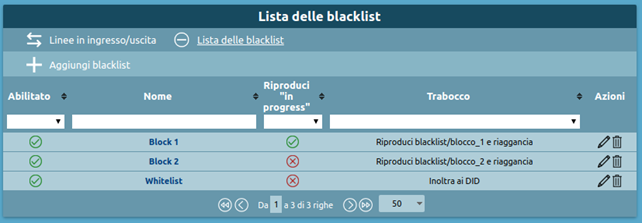Differenze tra le versioni di "AdminGuide:Service:Blacklist/en"
(Creata pagina con "The blacklists are applied to inbound calls, so in a single-tenant system they can be linked to the gateways and VoIP domains. In multi-tenant systems, the blacklists are mana...") |
|||
| (17 versioni intermedie di 3 utenti non mostrate) | |||
| Riga 15: | Riga 15: | ||
The blacklists are applied to inbound calls, so in a single-tenant system they can be linked to the gateways and VoIP domains. In multi-tenant systems, the blacklists are managed by the tenant admins and are linked to the assigned lines. | The blacklists are applied to inbound calls, so in a single-tenant system they can be linked to the gateways and VoIP domains. In multi-tenant systems, the blacklists are managed by the tenant admins and are linked to the assigned lines. | ||
You can also link a list of blacklists to each inbound line. These blacklists will be applied in a cascade after the manipulation rules and before the DID rules associated to the line. | |||
=== | === Configuration === | ||
To configure the service, you must first define the blacklist and then associate it to an inbound line. | |||
The blacklist configuration can be set in the PBX -> [[AdminGuide:BasicConcepts:Outbound_lines/en#Configuration|Gateways and VoIP domains]] -> List of blacklists page. | |||
[[File:Listablacklist.png|centro]] | [[File:Listablacklist.png|centro]] | ||
In | '''''N.B.:''''' In multi-tenant systems, the service can be configured in the PBX -> Assigned line management -> List of blacklists page. | ||
In this page you can create new blacklists by clicking on "Add blacklist" or edit and existing one. | |||
[[File:Listablacklistdettaglio.png|centro]] | [[File:Listablacklistdettaglio.png|centro]] | ||
The main fields of the form for defining the blacklist are the following: | |||
* Enablement | |||
* Name | |||
* Failover | |||
* Rules | |||
Rules can be ordered, but, as with the notes, this is purely for organizational purposes. Since they all have the same failover action, the first match will trigger the action. | |||
The association of the blacklist to the incoming line can be configurated on gateway and VoIP domains in PBX panel -> Gateway and VoIP domains -> Incoming/Outgoing lines <br>. | |||
''''' | '''''N.B.:''''' In multi-tenant systems, this can be configured in the PBX -> Assigned line management -> Assigned lines page. | ||
In either type of system, you can assign blacklists by clikcing on "Add blacklist" and adding all necessary blacklists. | |||
You can also disable all association of the blacklist with the inbound line so that its rules will not be applied. | |||
You can also reorder the blacklists within the inbound lines, so as to implement both blacklist and whitelist mechanisms. | |||
Versione attuale delle 13:08, 20 set 2022
Return to AdminGuide:Service
Blacklist
- Introduced in version 4.5.17
Description
This service lets you define specific routings for inbound calls based on the calling and called numbers.
For each pair of numbers, you can choose whether or not to play an audio file (even "in progress") and define the failover action to carry out (among the routing actions available on KPBX).
The pairs of numbers to which the same routing policy should apply can be grouped in blacklists to use on different inbound lines.
The blacklists are applied to inbound calls, so in a single-tenant system they can be linked to the gateways and VoIP domains. In multi-tenant systems, the blacklists are managed by the tenant admins and are linked to the assigned lines.
You can also link a list of blacklists to each inbound line. These blacklists will be applied in a cascade after the manipulation rules and before the DID rules associated to the line.
Configuration
To configure the service, you must first define the blacklist and then associate it to an inbound line.
The blacklist configuration can be set in the PBX -> Gateways and VoIP domains -> List of blacklists page.
N.B.: In multi-tenant systems, the service can be configured in the PBX -> Assigned line management -> List of blacklists page.
In this page you can create new blacklists by clicking on "Add blacklist" or edit and existing one.
The main fields of the form for defining the blacklist are the following:
- Enablement
- Name
- Failover
- Rules
Rules can be ordered, but, as with the notes, this is purely for organizational purposes. Since they all have the same failover action, the first match will trigger the action.
The association of the blacklist to the incoming line can be configurated on gateway and VoIP domains in PBX panel -> Gateway and VoIP domains -> Incoming/Outgoing lines
.
N.B.: In multi-tenant systems, this can be configured in the PBX -> Assigned line management -> Assigned lines page.
In either type of system, you can assign blacklists by clikcing on "Add blacklist" and adding all necessary blacklists.
You can also disable all association of the blacklist with the inbound line so that its rules will not be applied.
You can also reorder the blacklists within the inbound lines, so as to implement both blacklist and whitelist mechanisms.

